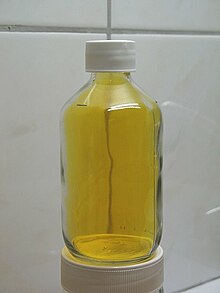Bromine monochloride

| |

| |

| |
| Names | |
|---|---|
| Other names
bromine(I) chloride
bromochloride bromine chloride | |
| Identifiers | |
3D model (JSmol)
|
|
| ChemSpider | |
| ECHA InfoCard | 100.034.169 |
| EC Number |
|
CompTox Dashboard (EPA)
|
|
| |
| |
| Properties | |
| BrCl | |
| Molar mass | 115.357 g/mol |
| Density | 2.172 g/cm³ |
| Melting point | −54 °C |
| Boiling point | 5 °C |
| Solubility in other solvents | 1.5 g/L |
Except where otherwise noted, data are given for materials in their standard state (at 25 °C [77 °F], 100 kPa).
| |
Bromine monochloride, also called bromine(I) chloride, bromochloride, and bromine chloride, is an interhalogen inorganic compound with chemical formula BrCl. It is an unstable brownish yellow gas with boiling point 5°C and melting point −66 °C. Its CAS number is 13863-41-7 and its EINECS number is 237-601-4.[1] It is a strong oxidizing agent.
Uses
Bromine monochloride is used in analytical chemistry in determining low levels of mercury, to quantitatively oxidize mercury in the sample to Hg(II) state.
Bromine monochloride is used as a biocide, specifically as an algaecide, fungicide, and disinfectant, in industrial recirculating cooling water systems.
Addition of bromine monochloride is used in some types of Li-SO2 batteries to increase voltage and energy density.[2]
See also
References
- ^ Gangolli, S. (1999). The Dictionary of Substances and Their Effects. p. 676. ISBN 0-85404-808-1.
{{cite book}}: Unknown parameter|coauthors=ignored (|author=suggested) (help) - ^ "Battery Chemistry - Lithium / Thionyl Chloride". GlobalSpec. Retrieved 2008-07-09.
